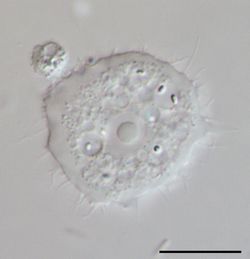Biology:Acanthamoebidae
| Acanthamoebidae | |
|---|---|

| |
| Acanthamoeba keratitis | |
| Scientific classification | |
| Domain: | Eukaryota |
| Phylum: | Amoebozoa |
| Class: | Discosea |
| Order: | Centramoebida |
| Family: | Acanthamoebidae |
| Genera | |
Acanthamoebidae is a family of single-celled eukaryotes within the group Amoebozoa.
It gets its name from Acanthamoeba, its best-known member. However, it also includes other species, such as Comandonia operculata and Protacanthamoeba bohemica.[1] Many kinds of Acanthamoebidae are highly prevalent in the soil and water of a variety of environments.[2][3] They are similar to Hartmannella, but have differently structured pseudopodia, in regard to the actin microfilaments that comprise them. Its most prominent member, Acanthamoeba, can be potentially pathogenic to humans and animals.[3]
It has been described as having a common origin with the Entamoebidae and Dictyosteliida.[4]
Structure
Members of Acanthamoebidae have a specific form of pseudopodia, dubbed acanthopodia.[5] These acanthopodia are continuously formed and reabsorbed, protrude from every area of the cell's surface, and are usually, short and fine. An exception would be A. astronyxis and A. comandoni, in which the acanthopodia may be quite long.[5] Sawyer and Griffin point out “[b]undles of actin microfilaments extend as rigid cores into acanthopodia”.[5] They are constantly formed and reabsorbed to induce locomotion, during which time the cell is typically triangular or cone-shaped.[5] The advancing acanthopodia are “wide and tongue-shaped, with irregular margins and filopodia.”[5] Sawyer and Griffin also note that the many acanthopodia contain axial bundles of the actin microfilaments, resulting in the irregular shape of the pseudopodia.[5] In regards to the typical physical size of the family Acanthamoebidae, they rarely grow larger than 65 µm or are smaller than 30 µm.[5]
Classification
The family Acanthamoebidae belongs to the order Centramoebida in the class Discosea, phylum Amoebozoa.[6] Within the family Acanthamoebidae are the following genera:[7]
- Acanthamoeba – 33 species.
- Comandonia – 1 species.[8]
- Dracoamoeba – 1 species.
- Luapeleamoeba – 2 species.
- Protacanthamoeba – 3 species.
- Vacuolamoeba – 1 species.
Prevalence
Members of Acanthamoebidae are highly prevalent in a variety of environments. In Osaka Prefecture, Japan , members (as well as Naegleria) were found in 68.7% of tapwater samples taken, despite purification.[2] Acanthamoebidae were also found in the St. Martin River near Ocean City, Maryland, and are very common in the surface waters of many oceans.[3]
Pathology
Acanthamoeba spp. can be potentially pathogenic to humans and animals.[3] Typically, a person or animal with a normally functioning immune system can avoid infection, but they "are known to be the opportunistic pathogens in granulomatous amoebic encephalitis (GAE), a chronic disease of immunocompromised hosts such as AIDS patients and transplants recipients.”[2] GAE is the result of microscopic cysts that form in the central nervous system. Acanthamoeba can also be the source of infections in the lungs, sinuses, skin, and eyes.[2]
References
- ↑ "www.ncbi.nlm.nih.gov". https://www.ncbi.nlm.nih.gov/Taxonomy/Browser/wwwtax.cgi?mode=Tree&id=33677.
- ↑ 2.0 2.1 2.2 2.3 Edagawa, Akiko; Akio Kimura; Takako Kawabuchi-Kurata; Yashiro Kusuhara; Panagio Karanis (2009). "Isolation and Genotyping of Potentially Pathogenic Acanthamoeba and Naegleria Species from Tap-water Sources in Osaka, Japan". Parasitology Research 105 (4): 1109–1117. doi:10.1007/s00436-009-1528-4. PMID 19565268.
- ↑ 3.0 3.1 3.2 3.3 Lewis, Earl; Thomas Sawyer (1979). "Acanthamoeba tubiashi n. sp., a New Species of Fresh-Water Amoebida (Acanthamoebidae)". Transactions of the American Microscopical Society 98 (4): 543–549. doi:10.2307/3225905.
- ↑ Odronitz F, Kollmar M; Kollmar (2007). "Drawing the tree of eukaryotic life based on the analysis of 2,269 manually annotated myosins from 328 species". Genome Biol. 8 (9): R196. doi:10.1186/gb-2007-8-9-r196. PMID 17877792.
- ↑ 5.0 5.1 5.2 5.3 5.4 5.5 5.6 Sawyer, Thomas; Joe Griffin (1975). "A Proposed New Family, Acanthamoebidae n. fam. (Order Amoebida), for Certain Cyst-Forming Filose Amoebae". Transactions of the American Microscopical Society 94 (1): 93–98. doi:10.2307/3225534.
- ↑ "187-gene phylogeny of protozoan phylum Amoebozoa reveals a new class (Cutosea) of deep-branching, ultrastructurally unique, enveloped marine Lobosa and clarifies amoeba evolution". Molecular Phylogenetics and Evolution 99: 275–296. 2016. doi:10.1016/j.ympev.2016.03.023. ISSN 1055-7903. PMID 27001604.
- ↑ "Expansion of the molecular and morphological diversity of Acanthamoebidae (Centramoebida, Amoebozoa) and identification of a novel life cycle type within the group". Biol Direct 11 (1): 69. 2016. doi:10.1186/s13062-016-0171-0. PMID 28031045.
- ↑ "Comandonia operculata". National Center for Biotechnology Information (NCBI). https://www.ncbi.nlm.nih.gov/Taxonomy/Browser/wwwtax.cgi?id=158896. Retrieved 24 August 2022.
Wikidata ☰ Q490998 entry
 |

